It’s odd to think that a place can be completely obliberated nearly overnight. But in the case of LeBreton Flats, it’s happened twice—first in 1900 when The Great Fire of 1900 hit Ottawa, which leveled a vast swath of Ottawa from Carling Avenue to the other side of the river into Quebec. While disasterous, the Flats were eventually rebuilt, becoming an important industrial area in the first half of the 20th century for Ottawa, as well as a vibrant working class neighborhood. But in 1962, another disaster hit, one from which it would prove nearly impossible to rebuild from: the National Capital Comission. The NCC had been working for years to purchase all the land in the area, and began evicting residents in 1962. By 1965, the neighborhood was demolished in the name of urban renewal.

Two children in the half-abandoned LeBreton Flats in 1963. Image courtesy Wikipedia.
If you’re interested in reading more about what went on, there is a good—though admittedly very biased—account online here.
The fact of the matter is, the neighborhood was nearly obliterated, and few traces of it remain in the windswept plain that took its place. However, it didn’t entirely disappear, as I discovered thanks to an article in the Ottawa Citizen (which, unfortunately, I can’t find again or I would link to it). So a few days ago, I set out to explore the tiny remnents of one of Ottawa’s lost communities.
What’s left of LeBreton is focused primarily on a tiny street called lower Lorne Avenue, which is a City of Ottawa historic district. Along with a few homes on connecting Primrose Avenue, it’s the most complete remains of the old LeBreton, aside from a few modern townhouses which were built before before the area’s heritage value was recognized.
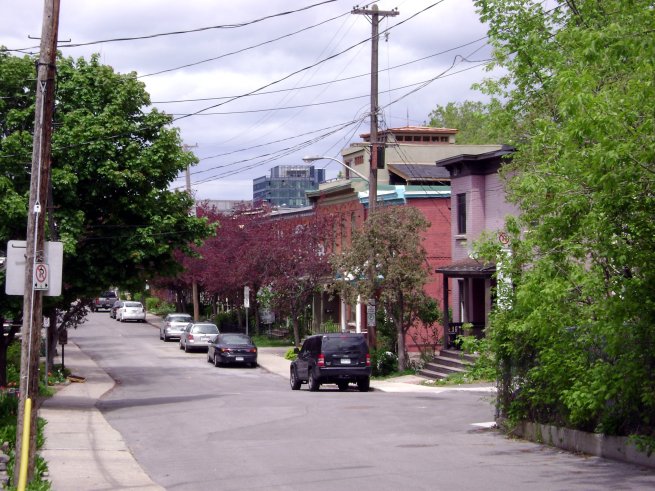
Looking up lower Lorne Avenue from Primrose Avenue.
Today, Lorne is a pleasantly middle-class street, no doubt bolstered by the heritage designation. Still, when you walk along the sidewalk, it’s easy to get a feel for what the old neighborhood must have been like. The houses are solidly built, if unremarkable, and are evocative of the similarly working-class heritage rowhouses found throughout neighborhoods like Lowertown.
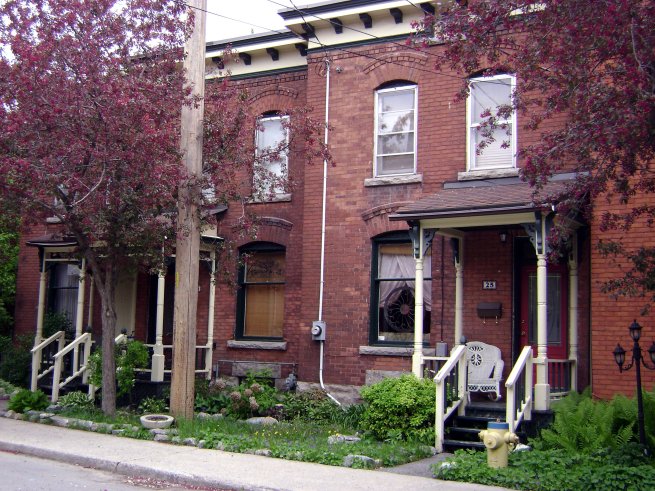
Typical residences on Lorne Avenue.
A couple of Lorne’s neighboring streets also survived the demolition, though they are far less intact. Perkins Street, one block over, is rather unique and almost seems like more of a laneway, as many of the houses on Lorne (as well as those along neighboring Empress Avenue) have direct backyard access to parking areas on Perkins. There are also a few remaining older residences along Perkins.
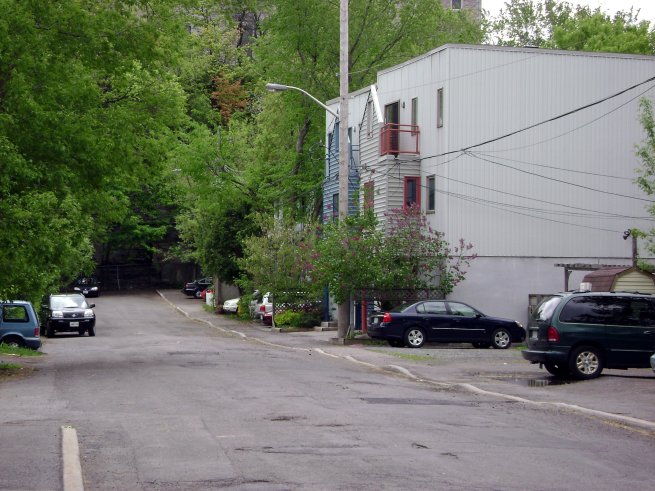
The laneway-esque Perkins Street.
Finally, there’s Empress Avenue. Though one side consists of a (relatively) modern health centre and its parking lot, the western side contains a few more rements of the old LeBreton Flats.
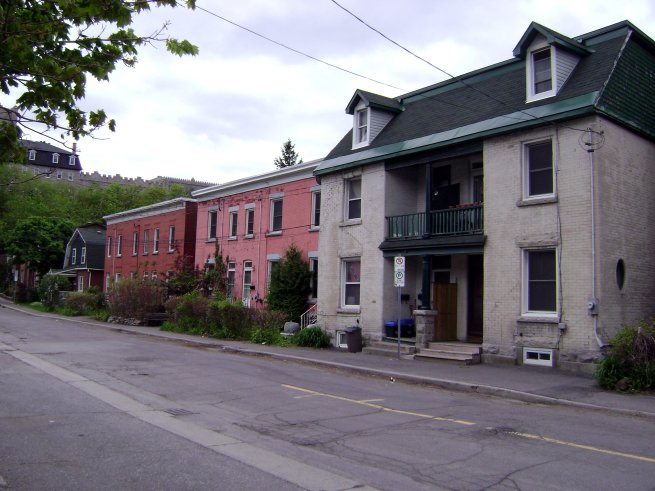
The west side of Empress Avenue.
Finally, at the very end of Empress, I noticed an impressive bit of infill. Unlike the 1970s-style townhouses which had popped up on Lorne and Primrose, some townhouses had been built which seemed very respectful of the street’s history and character and blended into the streetscape quite well. It’s exactly the sort of development I’d like to see more of in Ottawa’s older neighborhoods.
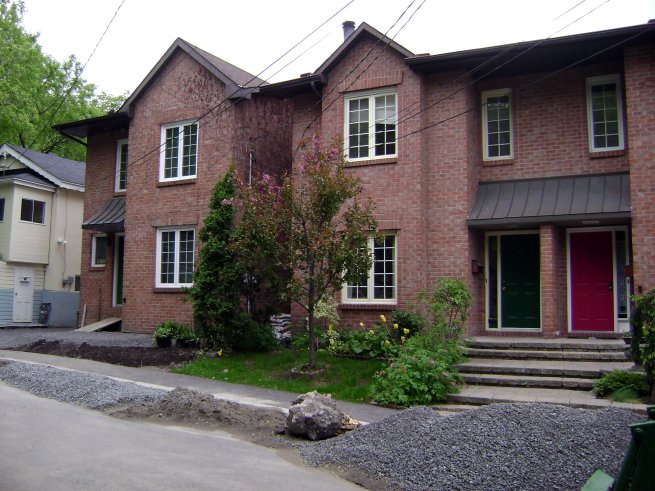
Newer townhouses on Empress, which appear more sensitive to the neighborhood than some developments.
I hope you’ve enjoyed a quick look at what’s left of the old LeBreton Flats, and I hope it gives you some idea of what must have once filled the area. It’s borderline tragic that Ottawa lost such a large historic district, but unfortunately what’s done is done. All we can do is try to hold on to what we have left.
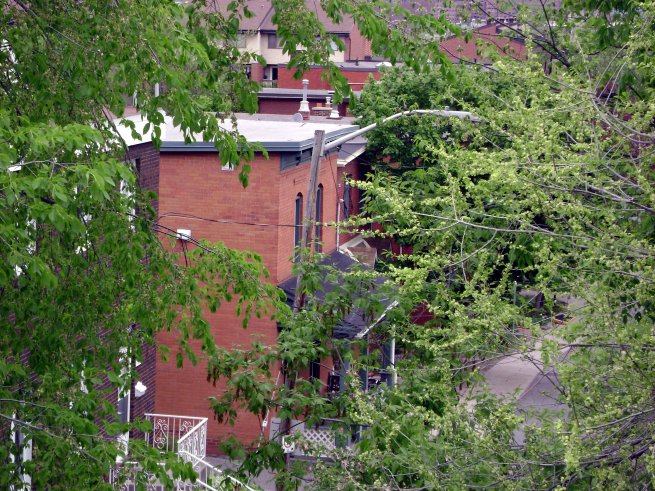
Peeking down at lower Lorne Avenue from atop Nanny Goat Hill.
——————————————–
Incidentally, if anyone else has any more nominations for Ottawa’s best park, please let me know over on the original post, here.

but dave… museums and condos! huzzah! lol
i absolutely agree with the infill being appropriate for the neighbourhood. as someone who grew up in a brick home built in 1900, i suggest that all homes be made with real brick, and with real construction techniques. time + money = quality.
I live in what remains of the Flats, just at the base of Nanny Goat Hill. You can actually see my house in the picture of the new infill townhomes on Empress, just to the left of them in the picture.
Lebreton Flats is one of the biggest absurdities of city planning in Ottawa. You have huge open fields, doing absolutely nothing right next to downtown Ottawa. In any sane city, that would have been rebuilt shortly after it was razed, or in the 80s development boom, or in the development boom that just ended. But no, Lebreton Flats is *still* windswept brownlands. There are some plans for the escarpment, but nothing concrete.
My biggest worry is that they decide to build more of the squashed-together monstronsities like the one that’s going up on the east side of the flats now. My biggest hope is that someone learns good lessons from buildings such as the ones that are going up in Westboro now, and bad lessons from places like Centrum in Kanata, and designs a livable neighborhood.
You may also want to recommend that your blog readers go out and purchase a book called An Acre in Time written by one of our own local historians Phil Jenkins. It is all about one acre of Lebreton Flats (http://www.philjenkins.ca/acres.htm).
Great exploration, thanks!
I think your overview is overly sympathetic to the demolished areas. I do not wish to take the view that it was right to demolish whole neighborhoods/built up areas in favor of total rebuilding, which was the big government view of urban renewal then (note to today’s amateur city rebuilders and commentators who too often wish for bigger govt action – be careful of what you wish for … ).
The Flats was a mixed use neighborhood. There were grotty warehouses and rail tracks and SLUMS there as well as some nice houses. We dont do ourselves a favor by sugar coating or idealizing the old neighborhood.
It is just plain wrong to assume that Lorne avenue represents what was built and demolished on the Flats. The NCC demolition targetted the polluted lands, the obsolete industrial uses and the structurally impaired housing. Their demolition continued south only as far as the worst structures went … for eg they went half way up Booth and stopped at Primrose but left the houses backing onto these from Lorne because the Lorne houses were structurally sound (and when I moved here 30 plus years ago, certainly not nice nor trendy). Similarly, only some units were demolised on Rochester, Preston, Primrose … leaving a gap-toothed landscape. But it was the bad-condition houses that were demolished and the good ones were left in place.
Phase one of Lebreton flats in 1980 built new housing around some of the survivors and this makes a fortunate transition zone from new townhouses to old community. Note that it was the city/government that built the remarkably ugly townhouses at the Albert st end of Lorne Ave that blight that streetscape.
In short, many of the houses on the Flats were demolished because they were substandard, slums, or structurally compromised. Certainly today, we MIGHT spend vast sums of public money to “save” and reposition such a neighborhood. Look at neighborhoods that were better than the Flats that were left alone – like Hintonburg, Mechanicsville, etc – which evolved to what they are today, with a lot of infill development of mixed quality and scale.
I dont think we should idealize the past and be nostalgic for a quality residential neighborhood that exists more in our imaginations than reality. Eddy McCabe wrote a lot about what it was like to grow up in that neighborhood, and it was anything but wonderful.
Those are all valid points, however I feel the need to note that at one point in time, neighborhoods like the ByWard Market and Hintonburg were pretty bad places to live as well. I think my biggest issue with LeBreton Flats is that the NCC simply stepped in and razed the area, without looking at what other options there were or without any real long-term plan for the site.
I realize that it wasn’t necessarily a great place to live back then, my main regret is that we’ll never know what the neighborhood could have become were it dealt with in a less heavy-handed matter.
Either way, it’s all academic. What happened happened and there’s no way to change that, only hope that the Flats is eventually redeveloped into a prosperous new neighborhood.
I posted a long comment over on Eric’s blog
turn it into a theme park! lol
I never knew the name of that…cliff…I keep thinking to call it…until this posting.
Nanny Goat Hill, huh?
A few Flickr photos to fix up the titles of!
My family has lived in Lowertown for 6 generations. We witnessed the destruction of a large part of our community. East Lowertown was demolished by the City of Ottawa and large parts of west Lowertown were torn down or expropriated by the National Capital Commission.
I think what is easily forgotten is not physical at all. The people who lived in these communities, like my family, often had generations of history in those places. They had extended family living near by and had developed relationships with many people in those communities. You can’t just replace generations of community building with urban renewal. I think that was the great failure of these planning schemes in the 50s, 60’s and 70’s. They had no room for protecting the dignity of these people’s lives and their communities. In fact, it sickens me.
My family, luckily, avoided urban renewal, but thanks to the City of Ottawa and the National Capital Commission, much of the people we once knew and their homes and businesses are gone. Urban renewal brought an end to a large part of our cultural and built heritage. In my opinion, that is a void that might never be replaced and I will always be the more poor for it. People place much less emphasis on community then when my parents and previous generations were growing up, but that does not diminish the richness of the communities that existed when people, like my family and many Lowertown residents, stayed in one place for many generations.
My family will always look back on urban renewal in Lowertown as a great tragedy. One for which I think both the NCC and City of Ottawa should apologize.
As a recent buyer in the new LeBreton Flats let me start by disclosing my vested interest. Here’s my perspective. If Ottawa wants to be more than Saskatoon with French, it would do well look at examples around the world of successful inner city revitalization: Vancouver, London, Edinburgh, Leeds, Toronto, Manchester, Brisbane, Stockholm, Amsterdam, Hamburg spring to mind. In all these places, neighbourhoods that resembled historic LeBreton Flats – former working class areas with light industry and transportation support mixed in – were to a greater or lesser extent demolished and replaced with walkable, liveable, mixed density. Byward Market has been a step in the right direction but it’s mostly protected and there isn’t going to be a lot of change or increased density except further to the east and that area is going to be gritty for many years to come. So for Ottawa, LeBreton Flats is an opportunity to reinvent the city just as False Creek, Docklands, Lakeshore, Leith etc etc have remade their cities in good ways. The fact things played out badly for complex reasons 40 years ago is unfortunate and maybe there are still some unresolved wounds that need to be healed. But nothing that happened in the past should be allowed to impinge on the present reality which is that Ottawa has a fantastic opportunity with this tabula rasa to build an exciting, magnetic community on the flats. Criticize the NCC for moving too slow if you like, but thank goodness the redevelopment didn’t happen 10 or 20 years ago – we’d be looking at a sea of teal and peach stucco, possibly of the leaking variety. Even worse, imagine what the prospects for any sort of public enjoyment of these lands would be had DND built Pentagon North there! It would be a fortress in the heart of the city. I note that Vancouver planner Larry Beasley was on one of the NCC’s design advisory panels for LeBreton. Ottawa was very lucky to have his contribution as he is the brains behind most of the goodness in Vancouver’s Yaletown development that includes among other things a nice reinvention of an old industrial area. He was later recruited by Dubai to add his magic dust to their desert folly, but I don’t hold that against him because they know he has something special. What does concern me about LeBreton Flats is that the vision is too muted and the planners seem afraid to provoke the nitwitterati who insist upon looking this gift horse in the mouth. The fact is we have a beautiful piece of empty ground with shoreline proximity, sightlines up Wellington, several historic buildings (ie the mill and the power station), incredibly good transportation links, and adjacent neighbourhoods that have everything the old LeBreton Flats had including the poverty and decrepit housing. In time these areas will be lifted up by a vital community at LeBreton Flats, just as adjacent areas in other cities have seen a collateral benefit. And imagine the synergy that will be created once Gatineau starts to do something with its magnificent, dormant industrial heritage just across the bridge. It reminds me of Montreal’s old town that is going to come back to life one of these days. I hear people taking shots against the developer Claridge, but by any reasonable measure they have achieved excellence of design and build quality. This is not a project free of risks – the fact that other developers fell out of the bidding leaving just Claridge is not evidence that Claridge is the one lacking in vision. It is evidence that the other ones couldn’t stomach an analysis that presumably puts the biggest part of the financial reward several years further down the track than their modelling would normally require. The points for this should be going to Claridge. I really sympathize with the NCC planning staff who by all appearances have to deal with an extremely narrow minded, parochial public and a mind-boggling set of variables owing in part to a regional transportation policy that does not seem to have been decided. (It could be worse – at least for this project they don’t have the Lansdowne ranters on their hands!) It would be good to see the NCC try to maintain a higher profile dialogue with all the citizenry on this issue, rather than simply follow the letter of the law in regards to public hearings etc. From the outside it looks like they are afraid to stick their necks out – a typical paradox for an entity with so many conflicting accountabilities. They should give more thought about how to to build the message, showcase the successes, and invite the public in not just on public hearing nights. In this way it could be hoped that the feverish few can be counterbalanced so their tedious gripes cease to be the whole story.